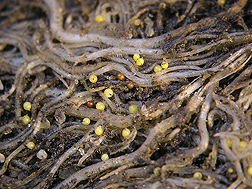This page has been archived and is being provided for reference purposes only. The page is no longer being updated, and therefore, links on the page may be invalid.
Read the magazine story to find out more. |
|
|
Scientists Seek New Ways to Control Potato Pests
By Ann PerryAugust 29, 2007
New and more virulent forms of two scourges that rampaged through potato fields in the past—the golden nematode (Globodera rostochiensis) and potato virus Y (PVY)—are making a comeback. But Agricultural Research Service (ARS) scientists are catching up to them.
Twenty years ago, stringent controls eventually confined the golden nematode—also called the potato cyst nematode—to several counties in New York, where it was first discovered. However, more than 30 varieties of potatoes that were previously nematode-resistant are now vulnerable to attack from a new race of the golden nematode, dubbed "Ro2."
Xiaohong Wang, a molecular biologist in the Plant Protection Research Unit (PPRU) at Ithaca, N.Y., is using molecular biology techniques to study specific parts of Ro2 DNA. This will help speed its field identification. She is also looking for ways to increase potato resistance to Ro2 using a method called RNA interference (RNAi), which interferes with gene expression.
A pathogen of potatoes as well as tomatoes, peppers and tobacco, PVY dramatically affects produce yield and quality. Although seed potatoes are screened for PVY, its resurgence is due in part to varieties that are symptomless carriers of the virus. Some PVY strains have also become more virulent over time.
Plant pathologist Stewart Gray, also at the PPRU, is coordinating a survey of all U.S. potato seed-production areas to determine PVY's genetic diversity and distribution in the United States. This is one part of a plan developed by an international team of scientists, regulatory personnel and industry representatives to manage potato viruses that result in tuber necrosis. These strategies will help stem the spread of PVY, and should help prevent necrotic PVY strains from becoming predominant in North America.
ARS research on these pathogens will help the potato industry remain viable and boost producer efforts to expand their markets.
ARS is the U.S. Department of Agriculture's chief scientific research agency.
Read more about this research in the August issue of Agricultural Research magazine.

